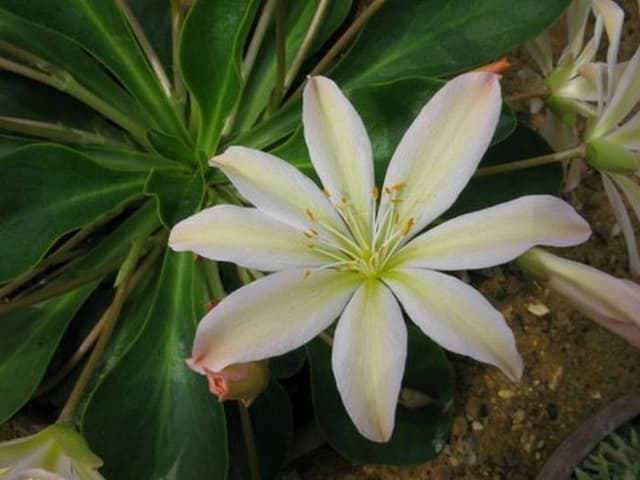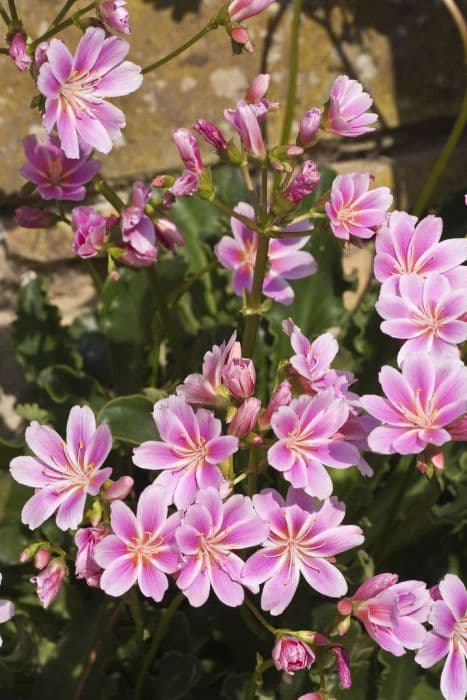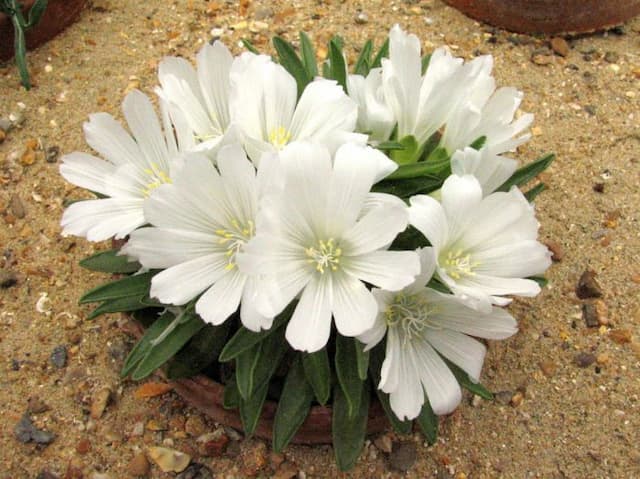Bitterroot Lewisia 'Little Snowberry' (Little Series)

ABOUT
Little Snowberry is a charming and eye-catching flowering plant that features a beautiful rosette of succulent, spoon-shaped leaves. These leaves typically display a rich, green color with a slightly fleshy texture that is indicative of the plant's ability to retain water. The overall foliage provides a lush and full appearance, creating an attractive ground cover or accent in a container. The centerpiece of the Little Snowberry's appeal, however, is its delightful bloom. The plant boasts an abundance of delicate flowers that rise above the foliage on slender, yet sturdy, stems. These blooms often appear in soft hues of pink, accentuated with subtle hints of white that blend together as if they were carefully painted by an artist. The flowers have a dainty, almost crystalline quality and are shaped like small cups or stars, with multiple petals radiating from the center. Each petal is finely textured, with gentle ripples that catch the light, making the flowers sparkle in the sunlight. The centers of the blooms may exhibit a subtle contrast with deeper shades or nuanced coloration that draws in pollinators as well as human admirers. The blossoming period showcases the plant’s vibrant energy, as it comes alive with a profuse floral display that can add a touch of whimsy and allure to any garden setting. In addition to its foliage and flowers, the overall structure and form of Little Snowberry convey a sense of compact elegance, with the plant maintaining a tidy and well-proportioned shape throughout its growth and bloom cycles. Despite its delicate appearance, Little Snowberry is known for its resilience and can lend a sense of enduring beauty to the spaces it inhabits.
About this plant
 Names
NamesSynonyms
Little Snowberry, Cliff Maids, Siskiyou Lewisia, Bitter Root.
Common names
Lewisia cotyledon 'Little Snowberry'.
 Toxicity
ToxicityTo humans
Little Snowberry (Lewisia 'Little Snowberry') is not commonly known to be toxic to humans. There are no widespread reports or documented cases that suggest the consumption or contact with the Little Snowberry causes poisoning in humans. Consequently, there are no specific symptoms of poisoning associated with this plant. However, it is generally recommended to avoid ingesting any plant parts unless they are known to be edible, to prevent any potential adverse reactions.
To pets
Little Snowberry (Lewisia 'Little Snowberry') is not commonly known to be toxic to pets such as dogs and cats. There is limited information regarding the plant's toxicity to animals, and it does not appear on most lists of toxic plants for pets. Thus, no specific symptoms of poisoning are typically associated with this plant. Nevertheless, pet owners should always be cautious and prevent their animals from eating ornamental plants, as even non-toxic plants can cause gastrointestinal upset or other issues if consumed in large quantities.
 Characteristics
CharacteristicsLife cycle
Perennials
Foliage type
Evergreen
Color of leaves
Green
Flower color
Pink
Height
0.5-1 feet (15-30 cm)
Spread
0.5-1 feet (15-30 cm)
Plant type
Herb
Hardiness zones
5
Native area
North America
Benefits
 General Benefits
General Benefits- Attractive Blooms: Produces charming pink or white flowers that add a burst of color to rock gardens and borders.
- Drought Tolerance: Once established, it has a good level of drought resistance, making it suitable for xeriscaping.
- Compact Growth: Its small size and compact habit make it an excellent choice for tight spaces and small gardens.
- Low Maintenance: Requires minimal upkeep beyond occasional watering and deadheading.
- Cold Hardy: Capable of withstanding cooler temperatures, it is suitable for a range of climates.
- Long Blooming: Offers a long blooming season, from late spring to early summer, providing extended interest in the garden.
- Alpine Origins: With its natural alpine habitat, it’s ideal for rockeries and alpine garden settings.
- Attracts Pollinators: Flowers are attractive to bees and butterflies, supporting local ecosystems.
- Non-Invasive: Unlike some other garden plants, it does not tend to spread uncontrollably.
- Evergreen Foliage: Retains its leaves year-round, providing ongoing visual interest even when not in bloom.
 Medical Properties
Medical PropertiesThis plant is not used for medical purposes.
 Air-purifying Qualities
Air-purifying QualitiesThis plant is not specifically known for air purifying qualities.
 Other Uses
Other Uses- Lewisias can be used in miniature gardens or fairy gardens because of their small size and attractive appearance, creating a whimsical landscape.
- Pressed flower crafts: The flowers of lewisias can be pressed and used for creating bookmarks, greeting cards, or in scrapbooking to add natural beauty to art projects.
- Photography subjects: The delicate petals and vibrant colors make lewisias popular among photographers looking for natural subjects for macro photography.
- Edging plants: Given their compact habit, lewisias can be planted along the edges of walkways or garden beds to define and brighten borders.
- Alpine troughs: Lewisias are an excellent addition to alpine trough gardens, which are designed to mimic high mountain environments in miniature.
- Rock garden accents: They can provide splashes of color in rock gardens, fitting into small crevices between stones where other plants might not thrive.
- Container arrangements: These plants can be grown in containers on patios or balconies, often in combination with other alpine plants, to create a portable display.
- Culinary garnish: Although focusing on the aesthetic rather than flavor, the blossoms can be used to adorn plates and add an edible flower touch to dishes.
- Art inspiration: Artists may use the striking form and colors of lewisias as inspiration for paintings, textiles, or other artistic expressions.
- Teaching tool: Lewisias can be used in educational settings to teach children or gardening enthusiasts about plant care, specifically the needs of alpine or rock garden plants.
Interesting Facts
 Feng Shui
Feng ShuiLewisia is not used in Feng Shui practice.
 Zodiac Sign Compitability
Zodiac Sign CompitabilityLewisia is not used in astrology practice.
 Plant Symbolism
Plant Symbolism- Resilience: The Lewisia, able to thrive in rocky soils and high altitudes, often symbolizes the ability to overcome challenging environments and hardships.
- Survival: Often found in harsh mountainous terrains, this plant represents the survival of beauty amidst difficult conditions.
- Tenacity: With its capacity to withstand drought and poor soils, Lewisia signifies determination and a tenacious spirit.
 Water
WaterBitterroot should be watered deeply but infrequently, allowing the soil to dry out between waterings to mimic its native alpine conditions. In general, water approximately once every week or two, depending on the climate and soil drainage—less often in cooler or wetter conditions and more frequently in hotter, drier climates. When watering, apply 1 to 2 gallons of water to the base of the plant, ensuring it soaks into the root zone without leaving the soil waterlogged. During winter months, reduce watering significantly, as Bitterroot is dormant and excessive moisture can lead to root rot.
 Light
LightBitterroot thrives best in full sunlight conditions. It should be placed in a spot that receives at least 6 to 8 hours of direct sunlight daily. A south-facing location is ideal, provided it is exposed to ample sunlight without any significant shade during the day. Avoid placing the Bitterroot in areas of deep shade or where buildings or trees significantly obstruct the light, as this can diminish flowering and overall plant health.
 Temperature
TemperatureBitterroot can tolerate a wide range of temperatures, adapting well from hardiness zones 3 to 8. They can survive minimum temperatures down to -40 degrees Fahrenheit (zone 3) and are quite hardy in cold climates. However, the ideal growing temperature for Bitterroot is between 60 and 75 degrees Fahrenheit during the active growing season. They can also withstand summer highs up to 90 degrees Fahrenheit, as long as they are not in a location that retains excessive heat.
 Pruning
PruningPruning Bitterroot is mostly about removing spent blooms and dead foliage to encourage healthy growth and flowering. Deadheading, or cutting off the old flowers after they fade, can stimulate a second bloom in some cases. Pruning is best done during the growing season after flowering has completed. You may also trim back dead or damaged leaves as needed but avoid heavy pruning as the plant doesn’t respond well to severe cutting back.
 Cleaning
CleaningAs needed
 Soil
SoilLewisia Cotyledon 'Little Snowberry' requires a well-draining, gritty mix with a slightly acidic to neutral pH of around 6.0 to 7.0. A good soil recipe may include a combination of potting soil, coarse sand, and fine pumice or perlite to ensure proper drainage which is crucial for the health of this plant.
 Repotting
RepottingLewisia Cotyledon 'Little Snowberry' should be repotted every 2-3 years or when you notice that the soil has degraded or the plant has outgrown its pot. It's best to repot in the spring just as the plant is coming out of dormancy.
 Humidity & Misting
Humidity & MistingLewisia Cotyledon 'Little Snowberry' prefers average to low humidity levels. As it is native to alpine regions, it does not require high humidity and can tolerate drier air typical of most indoor environments.
 Suitable locations
Suitable locationsIndoor
Place in bright, indirect light; ensure pot has drainage.
Outdoor
Plant in a sunny spot with well-draining soil.
Hardiness zone
4-8 USDA
 Life cycle
Life cycleLewisia 'Little Snowberry' begins life as a seed, usually germinating in the cool, moist conditions of spring. Once sprouted, the seedling develops a rosette of fleshy leaves at ground level, utilizing stored energy from the seed to grow. As the plant matures, it develops a strong root system to absorb water and nutrients from the soil. In late spring to early summer, it sends up flowering stalks bearing clusters of delicate, star-shaped flowers in shades of pink and white. After pollination, typically by bees and other insects, the flowers produce seeds, which are then dispersed to begin the next generation. Lewisia 'Little Snowberry' may enter a period of dormancy during hot or dry conditions, resuming growth with the return of cooler, more favorable weather.
 Propogation
PropogationPropogation time
Spring-Early Summer
The most popular method for propagating Lewisia 'Little Snowberry' is by dividing the crowns in early spring or after flowering. This task should be undertaken carefully to ensure that each division has a part of the root system and at least one growth point. Gently tease the crowns apart with your hands or use a sharp, clean knife to slice through the root ball, making sure to minimize damage. Once you have your divisions, plant them immediately in well-draining soil, ideally in a location that matches the light and moisture conditions they were originally grown in. Water the new divisions thoroughly but take care not to overwater, as Lewisia prefers drier conditions.




